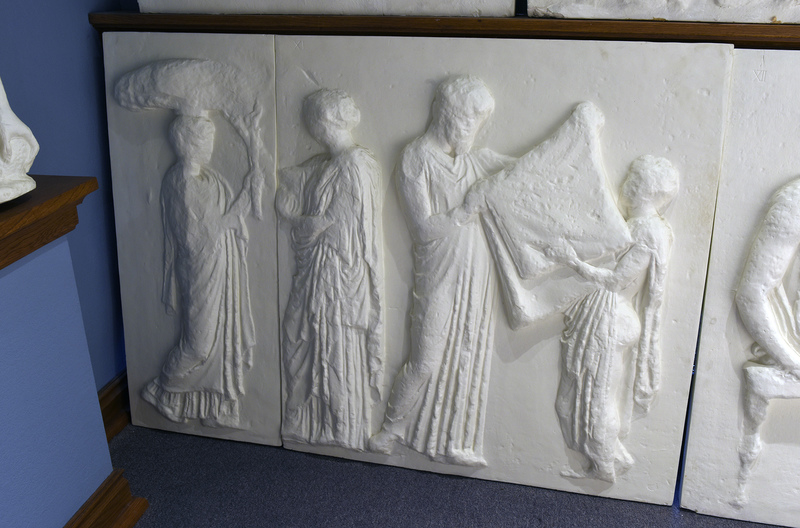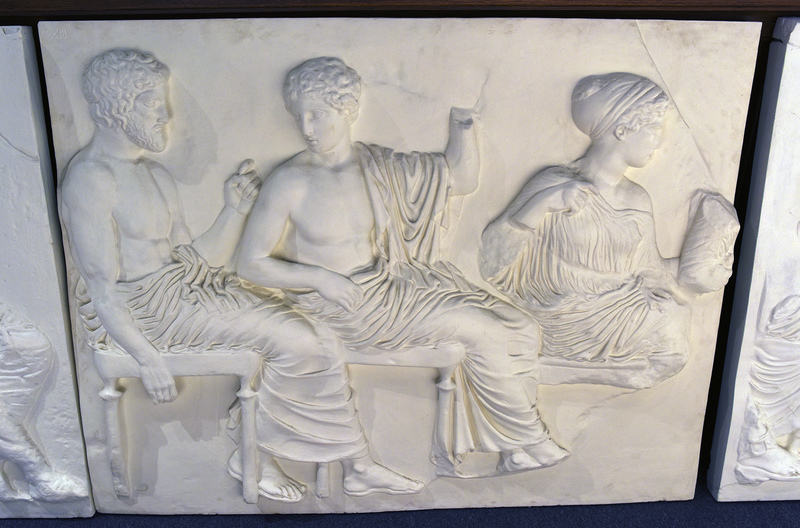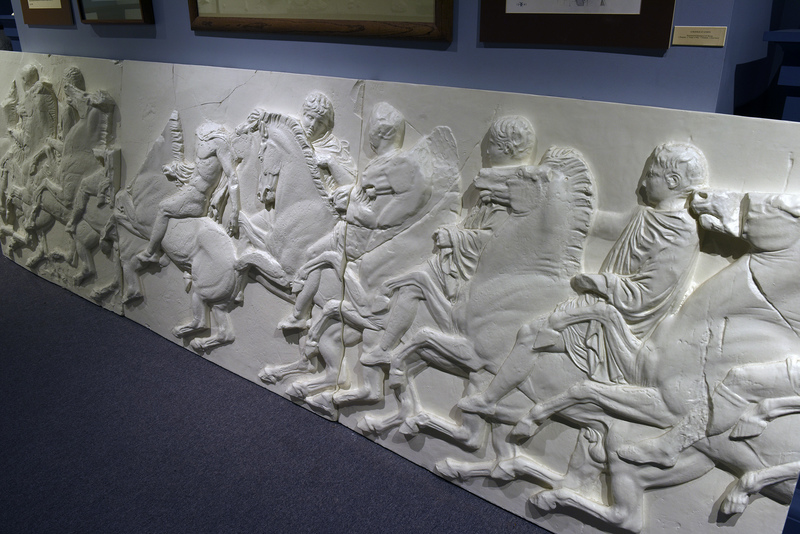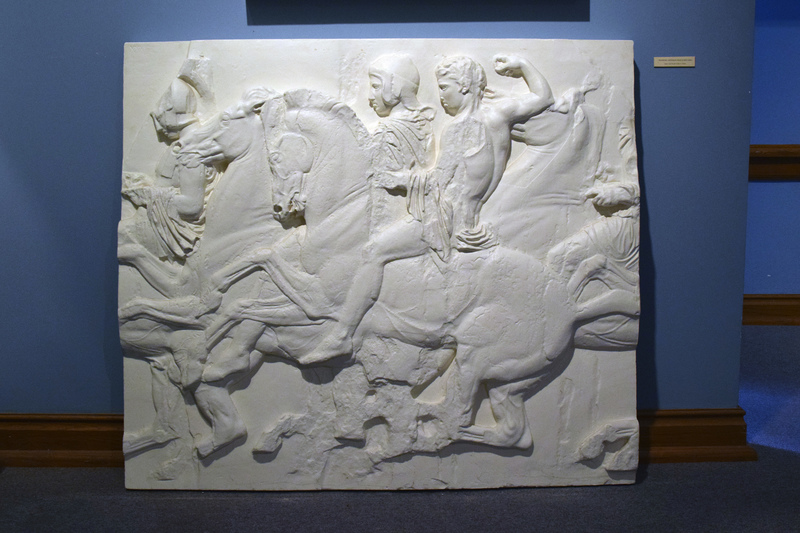The Parthenon Frieze
Item
- Title
- The Parthenon Frieze
- Description
-
Casts of originals in the British Museum, London. The frieze of the Parthenon is a long sculpted band of Pentelic marble on the top of the exterior wall of the cella (the central building inside the colonnade) and above the columns of the end porches. It was probably carved from 449 and installed by 440 BCE. The total length is 525 feet, and the height is 3 feet 4 inches. The frieze is carved in shallow relief, the 324 figures being no more than about 3 inches high off the background. The frieze was originally painted, blue for the background and various colors for the human figures and horses; there were also added bits of metal for reins and bridles and other objects. Most of the slabs are in the British Museum; some pieces are in Athens or elsewhere. Currently, the Greeks are seeking the return of all the Parthenon sculptures to Greece.
The Subject of the Frieze
The frieze runs thematically from the southwest corner first along the south as well as along the west and north sides towards the east. On these three sides the first subject is young men on horseback (all of the west and half of the north and south sides). After this "cavalcade," the north and south sides present chariot racing, then old men carrying branches, musicians (lyre players and flautists), young men carrying water jars and trays, and finally men bringing bovines and sheep. The east frieze is symmetrical flanking the central "peplos folding scene." From both ends walk young priestesses, then there stands a group of pairs of men in conversation, then gods sit on either side of the "peplos" scene (on the left are Hermes, Dionysos, Demeter, Ares, Hebe or Iris, Hera, and Zeus; on the right are Athena, Hephaistos, Poseidon, Apollo, Artemis, Aphrodite, and Eros). The "peplos" scene has 5 figures: at left, a young girl, and in the center 2 pairs of figures; at left, an adolescent woman and a young woman face each other, and, at right, a bearded adult man and a young child fold a large piece of cloth.
The frieze concerns the procession which took place every 4 years during the Greater Panathenaia (438, when the Parthenon was dedicated, was such a year; a Lesser Panathenaia was celebrated in the intervening years). On Athena's birthday in mid-August (28 Hekatombaion, the beginning of the Athenian year), all Athenians, resident aliens and slaves too, took part in a procession that started from the main gate, the Dipylon, in the northwest of the city, and passed through the market-place (agora) up to the Acropolis. The culmination of the procession was the presentation of a new gown (peplos) to the cult statue of Athena in the main temple to Athena on the north edge of the Acropolis (not the Parthenon). The frieze thus presents this procession in the presence of the Olympian deities, the presentation of sacrificial animals, and the folding-up of the old peplos. Scholars have long debated special topics about the Parthenon's frieze. For instance, which particular Panathenaic procession is being depicted (mythical, the one at the Parthenon's dedication, or any Panathenaia)? John Boardman counts the horseman as 192, the number of the Athenian heroes who died at Marathon fighting the Persians (490 B.C). The sex of the young child folding the peplos is also debated: the "Venus rings" on its neck should indicate a girl, but no girl bares her buttocks.
Style
The carving style is "High Classical." Some individuals are given different costumes (e.g., some of the horsemen) and the gods are given "attributes" that identify them (Demeter has her torch, Hermes his traveling hat) or given different ages (adult Zeus and youthful Apollo). But otherwise almost all the figures are ideally youthful and given "classical" (i.e., mathematical) proportions; faces are generic, not individualized, and all are calm and impassive. Modeling of the flesh is restained but fluid; costume ("drapery") folds are also restained, nothing fluttery as in the Parthenon's later pediments (in place by 432).
The Parthenon's Frieze in the Wilcox
The Wilcox Collection presents casts of most of what survives of the relief slabs from the east frieze, and casts of many of the better-preserved north frieze slabs . - General Information on the Parthenon.
- Bibliography
-
Pausanias, Guide to Greece I.24.5-7.
Plutarch, Pericles 12.5-13.
Boardman, J. 1985. Greek Sculpture. The Classical Period (London) 96-145.
Boardman, J., and D. Finn, 1985. The Parthenon and its Sculptures (Austin).
Brommer, F. 1963. Die Skulpturen der Parthenon-Giebel (Mainz).
Brommer, F. 1967. Die Metopen des Parthenon (Mainz).
Brommer, F. 1977. Der Parthenonfries (Mainz).
Castriota, D. 1992. Myth, Ethos, and Actuality (Madison).
Dillon, M., and Lynda Garland (eds.) Ancient Greece (London), no. 10.4. [building accounts]
Korres, M. 2000. The Stones of the Parthenon (Los Angeles)
Meiggs, R., and D. Lewis. 1969. A Selection of Greek Historical Inscriptions (Oxford) no. 59. [original Parthenon accounts in English]
Neils, J. (ed.) 1992. Goddess and Polis. (Princeton).
Palagia, Olga. 1998. The Pediments of the Parthenon (Leiden).
Pinney, G. Ferrari. 1988. "Pallas and Panathenaia," in Proceedings of the Third Symposium on Ancient Greek and Related Pottery (Copenhagen) 465-77.
Schmidt, M. (ed.) 1988. Kanon. (Antike Kunst Beiheft 15) (Basel).
Stanier, R.S. 1953. " Cost of the Parthenon," Journal of Hellenic Studies 73: 68-76. - Iconography
- Parthenon
- Findspot
- Athens




